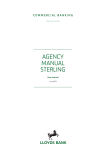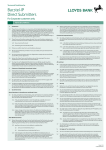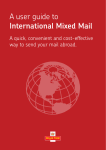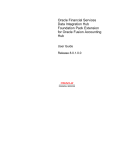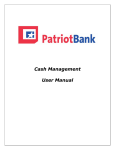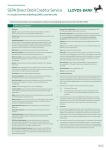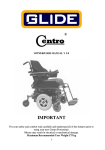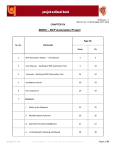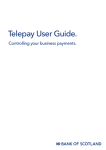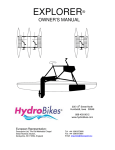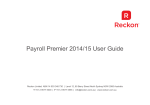Download AGENCY MANUAL EURO
Transcript
AGENCY MANUAL EURO User manual June 2014 Contents Introduction 4 Euro clearing 4 Euro payments 4 The Lloyds Bank Euro Processing Centre (LEPC) 4 Chapter 1 – Remitting Euro Denominated work to Lloyds Bank (Out clearing) 5 Principles for Euro paper processing 5 Domestic Euro Cheque 5 Foreign Euro Cheque 5 Clearing Cycle for Domestic Euro Cheques 5 Sterling Cheques or Cash cannot be paid into a Euro Account: 5 Acceptable Credits 5 Stationery 6 Cheques and Credits 6 Other forms 6 Daily Routines 7 Processing the Cheques 7 Transaction Codes for Debits 7 Verifying the Cheques 7 Paying Cheques into Your Euro Account 7 Completing the Daily Summary Sheet 7 Processing the Credits 8 Transaction Codes for Credit Remittance 8 Completing your Daily Bank Giro Credit (BGC’s) Remittances 8 Checking the finished Cheques/BGC’s Remittances 8 Remittance Differences 8 Differences Identified by Yourselves 8 Cheque(s)/Credit(s) listed within a remittance but not included in the remittance 9 Differences Identified by LEPC 9 Cheque(s) lost during the course of clearing 9 Cheque(s)/credit(s) remitted by yourself but not listed within a remittance 9 Cheque(s)/credit(s) incorrectly listed 9 Non clearing items 9 Chapter 2 – Processing your In-Clearing 10 Routine Procedures 10 Debit Clearing 10 Automated Euro Clearing Listing 10 Credit Clearing 10 Special Procedures 10 Unpaid cheques 10 Unpaids Inwards 11 Non Receipt of Unpaid Cheque 12 Non Receipt of Clearing Debit Advice 12 Uncrossed Returns 12 Missing Cheques Required To Be Returned Unpaid 12 Special Presentations 12 Stopped Cheques 12 Cheque Conversion Claim 12 Clearing Adjustments – Debits and Credits 13 Introduction and General Information 13 No clearings or wrong clearings received 13 Clearing Adjustments 13 Debit Clearing Adjustments 13 Wrongly Delivered Items (Drawn on another bank/financial institution) 13 Errors in Work 13 Missing items 13 Credit Clearing Adjustments 14 Chapter 3 – Lloyds Bank Contact List 15 Stationery for remitting Euro work 16 Stationery for In-Clearing 16 Special Procedures 16 Computer Listings 16 Introduction Euro payments Before you begin to use our Agency Service, it is vital that you understand how the service works and all that is required. In addition to cheques, customers will be able to make electronic same day value Euro payments to most banks in Europe, including the UK. Therefore, please read this manual carefully and ensure that you are able to comply with the standards and practices, which are outlined. The Lloyds Bank Euro Processing Centre (LEPC) Lloyds Bank is a Settlement Member of various UK Industry Payments Schemes. For a full list of payment schemes, please visit UK Payments Administration website at www.ukpayments.org.uk. Our interests are represented on all relevant committees and we also represent our customers (who are referred to as Agency Participants or Indirect Clearers). A business unit called the Lloyds Bank Euro Processing Centre (LEPC) is set up to deal with general clearing accounting entries (including incorrectly listed cheques/credits, missing items and items not listed). The LEPC can be contacted on: 0845 165 0413 Option 3. iPSL The Bank must also abide by all regulations and standards outlined by the industry bodies of the payment schemes. Throughout this manual, you will see that there are strict regulations which are governed by the Cheque and Credit Clearing Company (C&CCC) and other industry bodies. These include the issue of cheque books and the timescales for returning cheques, etc. Lloyds Bank has outsourced our paper clearing operations to iPSL (Intelligent Processing Solutions Limited). As our clearings provider, iPSL operate within the regulations and standards laid down by the Cheque and Credit Clearing Company and act as a directly accessible extension of Lloyds Bank. iPSL process all Euro dominated cheques drawn on the UK which are eligible to be remitted through the UK Euro Cheque Clearings. Finally, in various places you will be given contact numbers and departments within Lloyds Bank/iPSL, for complete addresses see Chapter 3. As an Agency participant, you are expected to adhere to these standards and practices. Your relationship manager will be pleased to answer any questions you may have regarding these regulations. As part of your day-to-day banking you will also be in regular contact with various specialised areas of Lloyds Bank and full contact details for these can be found in Chapter 3. Finally, Lloyds Bank is delighted to be working with you and is committed to helping ensure the successful operation of your Agency Banking. Euro clearing Unlike any other currency accounts domiciled in the UK, there is a national Euro paper debit clearing system. This means that if a customer pays in a cheque denominated in Euro and drawn on a bank in the UK, they will receive value on that cheque in a similar way for Sterling cheques drawn in this country. Cheques denominated in Euro but drawn abroad will still need to be sent for collection or negotiation as is currently the case. Only a Euro cheque clearing scheme is in operation currently within the UK, however if an inter bank credit clearing system is introduced at a later stage we will let you know. 4 of 17 Chapter 1 – Remitting Euro Denominated work to Lloyds Bank (Out clearing) It is intended that this chapter should cover most of the day-to-day routines and assist in overcoming problems that may be encountered with remitting work. Correctly presenting your remittances is important and failure to observe these instructions could result in delayed clearance of your remittances. Principles for Euro paper processing Domestic Euro Cheque A cheque, drawn in Euros, on a UK bank or a UK branch of a foreign bank, which is eligible to be remitted through the UK Cheque Clearings. These cheques are processed via iPSL. Foreign Euro Cheque A foreign Euro cheque is a cheque drawn in Euros, on a bank overseas. These cheques should be processed in accordance with existing foreign currency procedures and must not be included in your remittance to iPSL. Sterling Cheques or Cash cannot be paid into a Euro Account: Sterling amounts must be paid into a Sterling account. Acceptable Credits Euro denominated credits can only be accepted for accounts held at your own bank or your Euro settlement account held with Lloyds Bank. The Cheque and Credit Clearing Company has decided that, until further notice, there is no inter-bank Euro credit clearing for Euro. Clearing Cycle for Domestic Euro Cheques A Euro cheque which is to be credited to a Euro account will take 3 days to process (no conversion required). These cheques will enter the clearing cycle on the day of receipt (the evening of day one). 5 of 17 Stationery Cheques and Credits Other forms All cheques and credits passed through the Inter-Bank clearing must be printed by an accredited printer that is a member of the Cheque Printer Accreditation Scheme (CPAS). This scheme was introduced with the aim of tackling fraud involving company cheques. Members of CPAS have stringent standards to meet the requirements for security, paper quality and layout. Other forms which may be needed from time to time should be individually personalised to your bank. However, the layout should conform to agreed inter-bank standards and it is suggested that you copy the Lloyds Bank forms, examples of which are shown in Chapter 4. To ensure that your items meet this standard, please contact the Cheque and Credit Approval Group. Customers will be supplied with an initial stock of stationery automatically – for further supplies, please contact [email protected] You will need to use the following (form numbers are shown where appropriate): Daily Summary Sheet (Euro to Euro transactions) Brown Polylope (Euros to Euros paper clearings only) Branch Crossing Stamp Batch Tickets (personalised with your own unique Sort Code) In addition, you will need a supply of: Euro Clearing Adjustment Form (For use with accounting queries/difference resolution) Examples of the forms are shown in Chapter 4. 6 of 17 Daily Routines Processing the Cheques 4. Impress the‚ “Random Remittance Rubber Stamp” below the total on the listing, and include your bank name and today’s date. All cheques which are processed must meet CPAS Standards for paper quality, and must be encoded with a serial number, Sort Code, account number and transaction codeline details. to be processed. 5. Complete a bank giro credit for the credit of your Euro settlement account with the total of the cheque remittance. own bank or your Lloyds Bank Euro settlement account. 6. Complete the Daily Summary Sheet Euro to Euro Transactions. • These procedures must be followed, to allow your items • Credits can only be accepted for accounts held at your • A bank giro credit should be completed for paying Euro cheques into your Euro account. –– If more than one form is used it should be annotated accordingly. same credit. –– The details on the form(s) should be totalled to ensure they agree with the total of the Euro cheque add list. • Please never pay in Sterling and Euro cheques on the • Sterling cheques cannot be paid into a Euro account. • Please do not amount encode Euro cheques or the –– Keep one copy of the form, and send the remaining two copies with your remittance. associated credits. 7. Place the top copy of the tally roll, batch ticket and the bank giro credit in front of the cheques. Wrap the Daily Summary Sheet around the remittance and secure with a rubber band. NOTE: It is not permissible to deface your existing Sterling cheques for payment in Euro. Lloyds Bank will not accept defaced cheques and any such items will be returned by the paying Bank. 8. Place the entire remittance in the BROWN polylope. Note: Full code line data must be retained – either by microfilming all of your work, or another acceptable method which is available on the market. Transaction Codes for Debits A single transaction code, ‘05’, has been allocated to cover both Euro cheques and Euro Bankers Payments. Completing the Daily Summary Sheet Verifying the Cheques It is essential that the Daily Summary Sheet is always used, and that you send the top two copies with your remittance. This is because: When accepting a Euro cheque please check the following: • The cheque is drawn in Euros, on a UK bank, or a UK branch of a foreign bank and is eligible to be remitted through the UK Euro Cheque Clearings. • The cheque is not torn or defaced. • The payee’s name is stated and is the same as the customer’s name on the account to which the cheque is being credited. • The cheque is signed. • The words and figures agree. • The cheque is not out of date (cheques are normally valid 1. It provides the audit trail – if the cheques you remit were to be lost or destroyed, the paying bank may still settle on the data provided by such an audit trail (although on occasions the paying bank may require a photocopy of the cheque before they are prepared to make a pay/no pay decision). 2. It enables the LEPC to investigate any post settlement differences. A separate Daily Summary Sheet Euro to Euro Transactions must be completed as follows: for 6 months from the date of issue, unless otherwise stated on the cheque). • Till stamp the bottom of the form(s); • Complete your bank, branch name and Sort Code details. • There are no material alterations to the cheque. Paying Cheques into Your Euro Account 1. Remove all pins, staples, sprocket holes and other attachments from cheques as these are all causes of rejects and machinery breakdowns and could result in late clearance of the cheque(s). 2. Place your crossing stamp onto the front of each cheque. 3. Add list (on a duplicate tally roll) all Euro cheques and total the listing. 7 of 17 7. Place the entire remittance in the BROWN polylope. Always complete the individual credit details first, followed by the corresponding debit(s). Checking the finished Cheques/BGC’s Remittances Write the credit details across the sheet as follows: The following points should be checked before the cheques/credits are submitted. 1. Tick the Box marked Corp (Corporate customers). 2. Input your bank details in the customer’s name section. 8. Ensure the following types of voucher are not included in the remittance: 3. Input your Sort Code and account number. 4. Enter the number of corresponding debits. –– ‘Defaced’ cheques. 5. Input the amount of the credit in Euros. –– Sterling cheques (these should be paid in separately, according to the instructions in the Sterling version of this manual). Underneath the credit details, write the details of individual cheques as follows: 1. Input the payee’s name (in the customer name column). –– Cheques issued/payable abroad or drawn in a foreign currency. 2. Input the Sort Code and account number from the bottom of the cheque. –– Cheques/credits drawn on UK banks that are not eligible to participate in the UK Euro clearings. –– Postal and money orders. 3. Input the cheque number. –– Bills of exchange. 4. Input the amount of the debit. –– Tax vouchers. 5. Add list all the cheques taken from the Daily Summary Sheet(s) on a duplicate roll. –– National Savings Banking form B6. 6. Till stamp the top of the listing. –– Club or shop cheques: these items should not be printed with details of a Clearing Bank. 7. Ensure the cheques balance to the total of the credit. –– Euro travellers cheques. Processing the Credits 9. All items are correctly presented in accordance with the Euro cheque preparation checklist. All Bank Giro Credits being remitted must meet CPAS Standards for paper quality and layout, and must be encoded with a minimum codeline of Sort Code, amount and transaction code. Note – Full code line data must be retained – either by microfilming all of your work, or another acceptable method which is available on the market. Transaction Codes for Credit Remittance Remittance Differences The following transactions codes must appear in the MICR codeline of the Bank Giro credits: NOTE: Differences can only be investigated up to 12 months after the date of remittance. However, it is important to remember that wrongly encoded/listed items can be adjusted up to 6 years after presentation. 76 Personal/Business credit 89 Counter Credit Adjustments in respect of clearing differences will be made to your bank account under advice. Completing your Daily Bank Giro Credit (BGC’s) Remittances Differences Identified by Yourselves 1. Remove all pins, staples, sprocket holes and other attachments from credits. • Error identified and proven Pass a correcting entry to your nominated bank account. You will need to supply full details of the error. 2. Place your crossing stamp onto the front of each credit. • Error suspected but not proven 3. Add list (on a duplicate tally roll) all Euro BGC’s and total the listing. Obtain a computer printout from LEPC. 4. Impress the‚ “Random Remittance Rubber Stamp” below the total on the listing, which should include your bank name and today’s date. This printout may then be ticked back to your add listing in order to identify the error. 5. Complete one Banker’s Payment, or cheque, for the total of BGC’s remitted. 6. Place the top copy of the tally roll, batch ticket and the BGC’s in front of the Banker’s Payment or cheque. Wrap the Daily Summary Sheet around the remittance and secure with a rubber band. 8 of 17 Cheque(s)/credit(s) listed within a remittance but not included in the remittance Cheque(s)/credit(s) incorrectly listed If a cheque/credit is found in your office, which should have been included in a previous remittance, please attach to a compliment slip or memo, and give details of where and when it was previously listed, i.e. date and grand total of remittance; DCV total if available. Forward the cheque or credit to LEPC. Items forwarded in this way will be subject to a delay in clearance. Differences Identified by LEPC If a cheque/credit is incorrectly listed by you the LEPC will advise you by telephone of the error and then confirm by fax. A correcting entry will be passed to debit/credit your Lloyds Bank Euro settlement account. Non clearing items Should you include a cheque/BGC that is not eligible to be remitted through the Euro clearings; the value of the item will be debited/credited to your Lloyds Bank Euro settlement account, under advice. Additionally, the item will be returned to you for action by your bank/financial institution. Cheque(s) lost during the course of clearing If a cheque is lost during the course of clearing, you will be advised of the delay in clearance. LEPC will then endeavour to clear the item with the paying bank. If this action is unsuccessful, the beneficiary may be asked to obtain a duplicate cheque. Alternatively, and despite provision of a photocopy/code line details the paying bank/branch may refuse payment, i.e. lack of funds, payment stopped, etc. In this situation, LEPC will advise you and your Lloyds Bank Euro settlement account will be debited with the value of the missing cheque. Cheque(s)/credit(s) remitted by yourself but not listed within a remittance You may be required to identify where and when a cheque/ credit was listed within a remittance. If the cheque/credit cannot be identified as listed in a previous remittance, Lloyds Bank will pass a credit/debit to your Lloyds Bank Euro settlement account. 9 of 17 Chapter 2 – Processing your In-Clearing This chapter outlines the procedures which should be followed by you when processing the work which Lloyds Bank receives from the Clearing House on your behalf. Your in-clearing may consist of Euro cheques and credits to your Sort Codes, along with the debit/credit clearings computer listings. Each day you will either collect your morning work from a local Lloyds Bank branch, or have it delivered to you in a designated polylope. Routine Procedures Debit Clearing The following action should be taken: • Add-list all cheques over €1,000 in Part One of the ADC Automated Euro Clearing Listing NOTE: The following procedures should be done first thing every morning. You will receive an Automated Euro Debit Clearing Listing (AEDC) each working day, together with the cheques contained on it. In addition to the cheque number, account number and amount, the AEDC also shows the following information: ISN This column is currently blank. Sort CD This is the Sort Code of the collecting bank and will be blank. DIN This is an identifying number placed on the back of the cheque by iPSL as part of the inclearing process. Items of €1,000 and over are marked with a‚ “*” beside the account number and there are totals at the bottom of each page for cheques under €1,000 and €1,000+. This may be useful if your internal procedures require use of further routines for higher value cheques, e.g. for security purposes. There are three parts to the listing: listing, using the amount in figures field of the cheque NOT the encoded amount. This ensures that the collecting bank has correctly encoded these items and that any errors are identified as quickly as possible. • All cheques in Part Three should be add-listed in the manner described above. Credit Clearing If you offer your customers Euro accounts, and if you remit the associated Euro Bank Giro Credits from one of your branches to another via Lloyds Bank, you will receive the credits and accompanying Euro Credit Clearing Listing each morning. Remember that, as there is no inter-bank credit clearing for paper Bank Giro Credits (BGC’s) issued in Euros, only BGC’s remitted by one of your branches, for an account at another, would appear on this listing. Special Procedures Unpaid cheques Unpaids Outwards Part One Contains all cheques which have been processed IMPORTANT – Please note the 2-4-6 customer proposition by the automated systems in iPSL. only applies to Sterling denominated cheques therefore cheques drawn in Euros are considered out of scope. Part Two This section is not currently in use and will be blank. • Unpaid cheques should normally be returned on day 3 of the clearing cycle (day 1 being the day they were paid into Part Three Contains cheques which have been ‘rejected’ – the collecting bank) – i.e. the day you receive them. An extra i.e. it has not been possible to process them on day may sometimes be added to the Clearing Cycle to allow the automated system. items presented in Scotland and drawn on offices of banks in England and Wales to be cleared (and vice versa). • You must write the reason for return in red ink on the top left corner of the cheque and send it to the collecting bank by 1st class post with a ‘Euro Advice of Unpaid Item’ form (see below for details). 10 of 17 • The banking industry has agreed wording of acceptable If necessary, a cheque may be returned on the following day (day 4 of the clearing cycle) under the ‘inadvertence rule’ which allows ‘late’ return of cheques under certain circumstances which are: reasons for return and these are shown below. No other reason should be written on any cheque. • Unpaid Answers 1. Lack of funds. List of Standard Answers for use by Banks when Returning Unpaid Cheques: –– Refer to drawer 2. Payment was stopped no later than the close of business on the day of presentation. –– Refer to drawer, please represent 3. The account has been closed. –– Effects Uncleared 4. The customer’s mandate has been terminated, e.g. by death or garnishee order. –– Not signed in Accordance with Mandate –– No Mandate This applies also to a cheque paid in at the drawee branch (i.e. a ‘house’ cheque not remitted through the clearing system) unless advice of fate has been given committing the drawee bank to pay. Cheques CANNOT be returned after day 4. –– Payment Stopped –– Payment Stopped – Theft Reported –– Payment Stopped – Awaiting Confirmation – Please Represent • If you are returning a cheque on day 4 (known as a ‘late return’) and the amount is over €500, you must phone the crossing branch, BEFORE 12:00 noon, and tell them of the return. Take the first and last name of the person with whom you speak. Be sure to write their full name on the back of the item to be returned. –– Payment Prohibited by Legal Order –– Payment Prevented – Insolvency Act Proceedings –– Crossed by Two Bankers –– Drawer Deceased • Cheques being returned for technical reasons (e.g. signature –– Suspected Fraudulent/counterfeit Cheque differs) should always be returned on the date of receipt. –– Account closed • The Euro Advice of Unpaid Item form is in two parts: –– Account Transferred – Try 00-00-00 –– No Account i. A ‘top’ copy which is passed through the clearing and should therefore include the destination Sort Code and transaction code 07 in the code line. ii. A ‘back’ copy which is sent together with the cheque bearing the reason for return by 1st class post to the collecting bank branch or central processing centre. –– Non clearing Item –– Post Dated –– Out of Date –– Words and Figures Differ –– Alteration Requires Drawer’s Signature • To use the form: –– Payee’s Discharge Required/Irregular –– Obtain the collecting bank Sort Code from the crossing stamp on the cheque. –– Cheque Incomplete –– Cheque Drawn in Pencil –– Mutilated Cheque –– Refer to Drawer – Not Drawn in Accordance with Cheque Card Criteria –– Signature Differs – Not Drawn in Accordance with Cheque Card Criteria –– Payment Stopped – Not Drawn in Accordance with Cheque Card Criteria • Other Standard Answers Where Cheques Are Missing –– Original Cheque Required –– Missing Item – Drawer Refuses Permission to Debit –– Missing Item – Unable to Obtain Drawer’s Permission to Debit –– Refer to Drawer – Insufficient Funds – Please Represent –– Advice of Drawing Required – Please Represent –– Complete the details on the on the Euro Advice of Unpaid Item and add your crossing stamp to both copies. –– Send the bottom copy, with the cheque, by 1st class post to the collecting bank. –– Include the top copy in your Euro debit outclearing remittance to iPSL – this will be passed through the Euro debit clearing to debit the collecting bank with the amount of the cheque. Unpaids Inwards • Other Answers for Cheques Returned by Banks in Scotland –– Refer to Drawer – Insufficient Funds –– Using this information, obtain the address of that bank from the Sort Code directory. Unpaids will be returned via LEPC. The LEPC will debit your Euro settlement account accordingly and forward the cheque with a covering letter to you by 1st class post. The cheque will normally be received by you on day 5 or 6 of the clearing cycle. • If you cross Euro cheques with your own Sort Code details prior to remitting them to Lloyds Bank, the returning bank may debit you direct by Euro Advice of Unpaid Item form through the automated debit clearing. • The cheque and advice should be received by you on the 4th or 5th day of the clearing cycle. 11 of 17 • Timescales can be delayed if the crossing stamp on the item Special Presentations is unclear or omitted. Non Receipt of Unpaid Cheque • If a debit is received for which you have not received a corresponding unpaid cheque, contact the returning bank immediately requesting full details of the debit. The returning bank will supply you with information which should enable you to debit the payee for the amount unpaid. • If you do not subsequently receive the cheque, the debit should be passed to the beneficiary’s account and you should advise the beneficiary to obtain a duplicate cheque from the drawer. • If the debit was generated to your Sort Code in error, it should be returned to the originator by the issue of a Euro Advice of Unpaid Item form. Send the advice portion, annotated with the reason for issue, by 1st class post to the originator. You may be asked by another bank to determine fate on an item drawn on a customer of yours as a Special Presentation (or Direct Remittance). In this case, you will receive items directly from the presenting bank, and you will need to have procedures in place to handle such items. When presented by post, the cheque must be accompanied by an advice form. When you receive a cheque as a special presentation, you must give advice of fate over the telephone, and give your name if asked to do so to by the requesting bank. Once fate has been advised in this way, this is a final answer and cannot subsequently be reversed. As there is no credit clearing, settlement for specially presented cheques must be made by an electronic Euro payment method or Bankers payment/cheque (in Euro) – the remitting bank may request any of these forms of settlement. Non Receipt of Clearing Debit Advice Additionally, you will need to develop a form for making your own Euro Special Presentations. If the debit advice has not been received within 3 working days after receipt of the unpaid cheque, the returning bank/financial institution must be contacted. Stopped Cheques Uncrossed Returns If the crossing stamp of a cheque to be returned unpaid is absent or illegible, the cheque should be stapled to the top portion of a completed Euro Clearing Adjustment Form and sent to LEPC on the first working day. NOTE: Please remember to look on the back of the returned cheque to see if a rear endorsement has been used which will enable you to ascertain the collecting bank Sort Code and thus return the cheque via normal procedures. The reason for dishonour must be annotated IN FULL, in red ink on the top left portion of the cheque. The original item should be marked confirmation of fax. Before despatch, a facsimile advice (of the adjustment form and a copy front and back of the cheque) and a telephone call must be made to LEPC. Missing Cheques Required To Be Returned Unpaid Complete and submit a Euro Clearing Adjustment Form on the day the item was listed in your Automated Euro Debit Clearing with the reason for return and the sequence number/date from the automated debit listing entered on the top portion of the form. Please also include a clear copy of the Automated Euro Debit Clearing listing with the item annotated ** either side of the codeline details. Before despatch, a facsimile advice (the adjustment form and a copy of the Euro ADC listing, with the item marked ** either side of the codeline details) and a telephone call must also be made to LEPC. Stopped cheques must be returned on day of presentation, with an answer advised in full, not abbreviated. To accept a stop payment from a customer, you must have a written request (a telephone call can be accepted; however, it must be followed up by written confirmation). Cheque Conversion Claim Beneficiary claiming non receipt of funds In the event that a customer contacts you advising that their account has been debited in respect of a cheque for which the beneficiary is claiming non receipt of funds you should contact the LEPC requesting that they put a “trace” on the item. To enable the LEPC to investigate they will require a clear photocopy (front and back of the cheque) with details of where the cheque was listed in your debit clearings including the date and total of the clearings. LEPC will contact the collecting bank to establish if the correct beneficiary has been credited with the proceeds. If the collecting bank advises they have credited the wrong account in error they should pass correcting entries and advise LEPC of their actions. Upon receiving confirmation that correcting entries have been passed by the collecting bank the LEPC will advise you accordingly. If it transpires the cheque is a “potential” cheque conversion you will need to contact the collecting bank’s branch direct in writing stating that you believe the item which was deposited at their branch counters has been converted, and you require immediate reimbursement of funds. Clear copies (front and back) of the paid cheque should accompany the claim to the collecting bank. 12 of 17 Clearing Adjustments – Debits and Credits Introduction and General Information Errors in Work • Items incorrectly listed No clearings or wrong clearings received If you receive the clearings of another agency customer, or do not receive any clearings at all, please contact iPSL Customer Care (Helpdesk). Clearing Adjustments If a cheque is not listed, is missing, or wrongly listed but correctly encoded you will need to complete a Euro Clearing Adjustment Form. You should debit the customer’s account and complete a Euro Clearing Adjustment Form. completed and a photocopy of the item (front and back) attached. • Send these forms directly to LEPC. • A separate form should be used for each adjustment. Before despatch, a facsimile (of the Euro clearing adjustment with a copy of the subsequent clearing listing or front and back copy of the cheque) and a telephone call must be made to the LEPC. The form, front and back copy of the cheque and a copy of the Automated Euro Debit Clearing listing must be sent direct to LEPC on the first working day by 1st class post to the following address: Lloyds Bank plc iPSL Euro Processing Centre (LEPC) International Service Centre Blaise Pascal House 100 Pavillion Drive Northampton NN4 7YP The adjustment form should be completed with as much detail as is available and sent by direct post together with a photocopy of the item (front and back) to LEPC. The LEPC will arrange to debit your Euro settlement account in respect of the over cheque. Before despatch a facsimile (of the Euro clearing adjustment form with a copy front and back of the cheque) and a telephone call must be made to LEPC. • Not listed on the automated debit clearing listing Should the item(s) be for another bank you should contact LEPC immediately: Missing items • Missing Items (General) If a photocopy of a cheque is available, it should be debited to your customer’s account without their authority (this is standard inter-bank practice, and we would expect, in all but extremely unusual circumstances, for you to adhere to this practice). NOTE: It is important that you use the correct form and corresponding address for adjustments. All differences, errors, problems, etc. must be dealt with on an immediate urgent basis, as delays can adversely affect your success of achieving reimbursement of funds, reconciliation and agreement of your clearings. If codeline details only are available it is also standard inter-bank practice that you would pay against codeline details and pass a debit to your customer’s account. If you choose not to pay the cheque(s) for any reason, you must inform LEPC in writing with a valid reason for return. We cannot refuse payment against such items without your authority in writing. Debit Clearing Adjustments • Missing Items and (Account/Cheque number missing) Wrongly Delivered Items (Drawn on another bank/ financial institution) • Listed on the Euro automated debit clearing listing. Contact the LEPC for advice as they may be in a position to pass a correcting entry. Contact the LEPC for advice as the paying bank may have notified the LEPC of a missing item. Before despatch a facsimile (of the Euro clearing adjustment form with a copy front and back of the cheque) and a telephone call must be made to LEPC. • Item is received but not listed • A Lloyds Bank Euro clearing adjustment form should be • Not listed on the automated debit clearing listing A Euro Clearing Adjustment Form should be submitted. Please staple a photocopy of both sides of the ‘offending’ item to the top portion of the form. If an item is missing and there is insufficient detail to post to the customer’s account, you should advise the LEPC by completing a Euro clearing adjustment form. Before despatch, a facsimile (of the Euro Clearing Adjustment Form with a copy of the listing) and a telephone call must be made to LEPC. –– attach a copy of the relevant section of the listing, clearly highlighting the missing item and marked confirmation of fax. –– send by 1st class post direct to LEPC within the working day. 13 of 17 • Missing Items (with full codeline details available in the • Credit(s) listed incorrectly Debit customer if customer is identifiable. Credit the correct value to the beneficiary account and submit a correcting Euro Clearing Adjustment Form, with a photocopy of the item attached to the top portion of the form. day’s work) If customer is unidentifiable, you should advise LEPC by completing a Euro clearing adjustment form. Before despatch a facsimile of the Euro Clearing Adjustment Form (with a copy of the listing and front and back of the credit) Before despatch a facsimile (of the Euro Clearing Adjustment and a telephone call must be made to LEPC. Form with a copy of the listing) and a telephone call must be made to LEPC. • Items that cannot be applied –– attach a copy of the relevant section of the listing, clearly highlighting the missing item and marked confirmation of fax. Contact the remitting bank/financial institution requesting further details. If the remitter’s endorsement is illegible or missing, write to LEPC requesting this information. LEPC will require the work date, the total value of the clearing and the amounts of the two BGCs either side of the un-applied BGC on the listing. –– send by 1st class post direct to LEPC within the working day. • Missing Items (Required to be returned unpaid) Complete a Euro Clearing Adjustment Form stating the reason for not paying the cheque and securely attach a copy of the relevant listing. The missing item should be clearly highlighted on the listing. • Listed to you in error Contact LEPC for advice and retain a photocopy of the item with the day’s work. Before despatch a facsimile (of the adjustment form with a copy of the listing) and a telephone call must be made to LEPC. • Send the form and listing by 1st class post to LEPC marked confirmation of fax. • LEPC will take responsibility for advising the Bank’s Clearing Department of the cheque’s fate. NOTE: Should the cheque subsequently arrive at your branch, it is essential that LEPC are immediately contacted by telephone for advice. Under no circumstances should you ring the encashing bank’s clearing department or branch directly. Credit Clearing Adjustments • Credit(s) listed but not received If you require a copy of the BGC for your records write to or telephone the LEPC, to arrange for a photocopy of the original BGC. The following information will be required: 1. Work date. 2. The total value of the clearing. 3. The amounts of the two BGC’s either side of the missing BGC on the list. • Credit(s) received but not listed If the credit(s) is payable to yourselves, credit the beneficiary’s account and submit a Euro Clearing Adjustment Form. Staple a photocopy of the front and back of the BGC to the top portion of the form. If the credit is payable to another bank/financial institution, forward the BGC to the Supervisor LEPC, with a brief note detailing when/how received. Keep a photocopy of the BGC with your day’s work. 14 of 17 Chapter 3 – Lloyds Bank Contact List Missing Work – Agency Cheque Services Non delivery of any one/all/combination of the following daily deliverables: •Paper Debit Clearing Valid (Prime) items •Paper Debit Clearing Manual (Reject) items •Paper Debit Clearing Listing •Agency Cheque Services Media Phone: Customer Care (Helpdesk) on 01582 646123/01582 646124/01582 646125 Paper Clearing and Accounting Enquiries General Paper Debit Clearing accounting enquiries (including incorrectly listed cheques, missing cheques and cheques not listed) General Paper Credit Clearing accounting enquiries (including incorrectly listed credits, missing credits and credits not listed). Phone: LEPC on 0845 165 0413 Option 3 Fax: 01604 570414 and 01604 570424 Lloyds Bank plc iPSL Euro Processing Centre (LEPC) International Service Centre Blaise Pascal House 100 Pavillion Drive Northampton NN4 7YP Cheque and Credit Slip Approval and Testing Phone: Cheque and Credit Approval Group on 0151 210 4114 Cheque and Credit Approval Group iPSL 1st Floor Operations Bridle Road Bootle Merseyside L30 4AA 15 of 17 Chapter 4 – Example Euro stationery, printouts, and forms Stationery for remitting Euro work Please find in the following pages examples of stationery referred to in the Euro Agency Manual. Daily Summary Sheet Euro to Euro Transactions Also, please note: Brown Polylope (Euros to Euros paper clearings only) All forms and stationery which you use must be vetted by Lloyds Bank before you use them. Before you have paying-in books, cheque books, or forms printed, please send them to your relationship team for them to liaise on your behalf with the appropriate department of Lloyds Bank. 43U – Batch Ticket (Euro) Stationery for In Clearing Euro Advice of Unpaid Item If you are opening a new Agency, the Sort Code will not be put in operation until your stationery has been approved. Special Procedures Euro Clearing Adjustment Form Euro Special Presentations Form Computer Listings Automated Euro Debit Clearing Report Euro Credit Clearing Report 16 of 17 For more information • isit V lloydsbank.com/commercialbanking • Contact your relationship manager Please contact us if you’d like this information in an alternative format such as Braille, large print or audio. If you have a hearing or speech impairment you can use Text Relay (previously Typetalk). Important information Lloyds Bank plc. Registered Office: 25 Gresham Street, London EC2V 7HN. Registered in England and Wales No. 2065. Telephone: 020 7626 1500. Authorised by the Prudential Regulation Authority and regulated by the Financial Conduct Authority and the Prudential Regulation Authority. Lloyds Bank International Limited: P.O. Box 160, 25 New Street, St Helier, Jersey JE4 8RG. Registered in Jersey, No. 4029. Regulated by the Jersey Financial Services Commission to carry on deposit taking business under the Banking Business (Jersey) Law 1991, and investment and general insurance mediation business under the Financial Services (Jersey) Law 1998. The Isle of Man branch of Lloyds Bank International Limited is licensed by the Financial Supervision Commission to conduct banking and investment business, and is registered with the Insurance and Pensions authority in respect of General Business. The Guernsey branch of Lloyds Bank International Limited is licensed to conduct banking, investment and insurance business by the Guernsey Financial Services Commission under the Banking Supervision (Bailiwick of Guernsey) Law 1994, the Protection of Investors (Bailiwick of Guernsey) Law 1987 and the Insurance Managers and Insurance Intermediaries (Bailiwick of Guernsey) Law 2002. PM1173 (06/14)

















